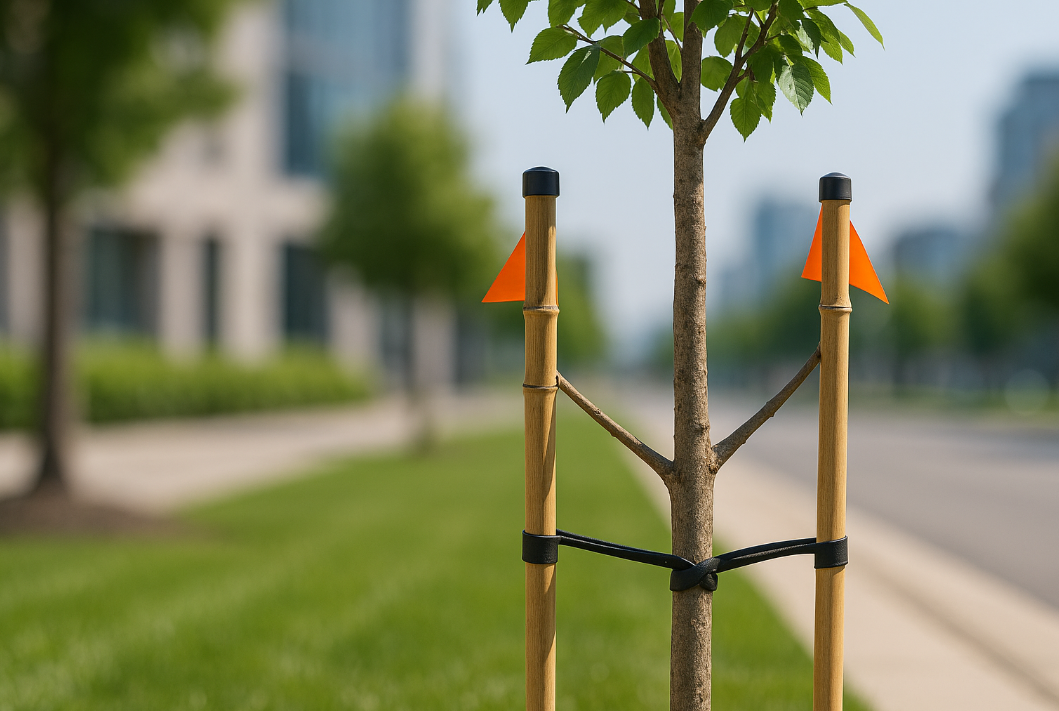Tree Bamboo Stakes: Sizing, Spacing & Installation Tips
Getting a young tree through its first windy season is half smart planning, half field discipline. This guide distills what crews, growers, and municipalities need to know about tree bamboo stakes—from when to stake to sizing, spacing, installation, and removal—so trees establish faster with fewer call-backs. As a factory-direct wholesaler, Wellco Wholesale supplies bulk garden, farm, hotel, supermarket, and landscape materials used on streetscapes and campuses; we reference those operational realities where it helps—no hard sell, just practical context.
Field note: on a coastal median last March, our crew re-set three leaning saplings after a storm by (1) moving stakes outside the rootball, (2) switching to elastic webbing with a figure-8, and (3) lowering tie height just below the first scaffold. All three held through the next wind event with healthy, controlled sway.
When (and When Not) to Stake Young Trees
Assessing site & tree conditions
Wind exposure, soil texture, root ball size, and trunk caliper drive the plan. Container stock on sandy, exposed sites typically needs support; B&B trees in sheltered clay loams may not.
Stake / Don’t Stake? (Decision Tree)
-
Stake if: site is high-wind or sloped; soil is loose/sandy; canopy is top-heavy; root ball shifts when tested; public safety/clearance requires temporary stabilization.
-
Don’t stake if: site is calm with cohesive soil; trunk stands plumb after watering-in; canopy mass is modest; there’s no vandalism or mower risk.
-
Reassess after storms and irrigation cycles; the goal is stability with gentle movement, not rigidity. (Arboricultural guidance such as ANSI A300 Part 3 emphasizes staking only when necessary and allowing limited sway.)
Recommended staking duration
Plan for 3–12 months depending on exposure and species. Check ties at each season change and after major wind. Remove as soon as the root plate holds without brace tension.
Choosing the Right Tree Bamboo Stakes (Sizing & Specs)
Quick dimensioning matrix (guide, not a code spec)
| Tree height | Typical trunk caliper | Site exposure | Stake length | Stake Ø | # per tree |
|---|---|---|---|---|---|
| 1–2 m | 15–25 mm | Sheltered | 90–120 cm | 8–10 mm | 1 |
| 2–3 m | 20–35 mm | Moderate | 150–180 cm | 10–12 mm | 2 |
| 3–4 m | 30–45 mm | Moderate–High | 210–240 cm | 12–16 mm | 2–3 |
| 4 m+ | 40 mm+ | High / corners | 240 cm+ | 16 mm+ | 3 (triangulated) |
-
Embed depth rule of thumb: drive ≈25–30% of stake length into firm soil (deeper in sands).
-
Upsize diameter for boulevards, corners, and hilltops; downsize where soils are dense and wind is low.
Quantity & tie materials
-
Single windward for light sites; opposed pair for most urban installs; triangulated for very exposed locations.
-
Use elastic tree ties or soft webbing; apply a figure-8 around the trunk and stake. Avoid bare wire (or sleeve it fully).
-
Add caps/sleeves for safety and longevity.
Procurement notes (trade buyers)
Specify straightness tolerance, node spacing, moisture control, and UV-stable ties. Wellco Wholesale supports mixed-carton diameters for multi-caliper corridors and can consolidate ties, caps, and flags on the same pallet to cut receiving touches.
Spacing & Placement Rules for Tree Bamboo Stakes
Distance from trunk & root ball
Place stakes just outside the root ball margin—typically 15–25 cm from the trunk on new installs—to avoid piercing the ball or circling roots.
Stake angle & orientation
Drive vertical in cohesive soils; lean 15–30° away from the trunk on windy, sandy sites to resist pull-out. Always align at least one stake to the prevailing wind.
Clearance planning
Maintain mower/line-trimmer clearance, keep sightlines near crossings, and avoid irrigation lines; use high-visibility flags where pedestrian traffic is close.
Installation: Step-by-Step Field Guide
Tools & prep checklist
Mallet or driver, measuring tape, elastic ties/webbing, sleeves/caps, PPE (eye/hand protection), utility-locate info, inspection tags.
Driving the stakes
-
Probe for utilities as required.
-
Drive to depth (≥25 cm or to refusal), verify plumb/angle, and check for wobble.
Attaching the tree
-
Set tie 5–10 cm below the first scaffold.
-
Figure-8 wrap; snug enough to limit whipping but loose enough to allow controlled sway (many crews use a “two-finger slack” check).
Quality check & sign-off
Perform a gentle sway test at crown height, confirm the trunk returns plumb, and tag the tree with install and first inspection dates.
Maintenance, Inspection & Removal
Inspection cadence
Every 2–4 weeks for the first 3 months, then at least once per season and after major wind events.
Adjusting or replacing ties
Loosen as the trunk thickens; replace UV-tired or abraded ties. Check that the figure-8 stays centered and notched sleeves remain intact.
Safe removal timing
When the tree stands plumb after irrigation and a hand-sway test, remove supports. Extract on moist soil days to minimize disturbance and backfill stake holes if needed.
Reuse & disposal
Trim ends, sanitize if reusing, and repurpose in beds or row crops. Follow local rules for composting or green waste.
Costing, Logistics & Supply Planning (Trade Buyers)
Estimating quantities
For streetscapes, plan 2 stakes/tree + 8–12% overage for breakage and site surprises; orchards and windbreak rows often use single-stake systems.
Unit economics
Factor materials + labor + revisit risk. Bamboo generally beats metal T-posts on material cost and handling time for young-tree stabilization; metal may be justified for vandalism-prone locations.
Storage & handling SOP
Keep bundles dry and shaded; rotate first-in/first-out; stage by caliper to speed crews. Wellco Wholesale can palletize by size and pre-bundle tie kits for crew issue.
Sustainability & Performance Considerations
Why bamboo?
Rapidly renewable, strong for its weight, and low embodied energy compared with metal stakes. Biobased material aligns with many municipal sustainability directives.
Longevity across climates
Seal cut ends; use sleeves in humid zones to reduce fray. In arid zones, periodic UV checks matter more than rot resistance.
Safety checklist (jobsite)
-
Cap stake tips; use high-vis flags near walkways.
-
Maintain mower clearance; install guards where string trimmers operate.
-
Use gloves/eye protection; confirm utility locates before driving.
Field Proof: Mini Case Study + Method Note
Project: City median re-tree, 62 trees, coastal corridor
Method: Opposed pairs of bamboo stakes with elastic webbing; ties set just below first scaffold
Observation period: first growing season
Outcome: Fewer corrective re-ties and improved first-season stability compared with prior single-stake approach.
Methodology & limitations: Observational crew logs; results are project-specific and not a controlled trial. Use as practical insight, not a universal benchmark.
Expert Tips (Arborist Input)
-
Place the tie where uncontrolled whipping stops—often just below the lowest scaffold.
-
Plan the removal date at install and put it on the inspection tag.
-
Allow some sway to promote trunk taper; staking that eliminates movement can hinder taper development.
Staking Install & Inspection Checklist (Printable)
-
Assess wind, soil, canopy balance, and rootball stability.
-
Choose stake length/Ø via the matrix; plan embed depth ≈25–30%.
-
Place stakes outside the rootball; verify angle to prevailing wind.
-
Use elastic webbing; apply a centered figure-8 below first scaffold.
-
Cap tips, add flags where pedestrians pass.
-
Tag install date + first inspection window.
-
Inspect at 2–4 weeks; loosen/replace ties as needed.
-
Remove supports as soon as the tree holds without brace tension.
About the Contributor
Written by a municipal landscape project manager with 8+ years coordinating campus and streetscape plantings, with input from an ISA-certified arborist. Wellco Wholesale provided procurement and job-staging perspectives based on factory-direct bulk supply across garden, farm, hotel, and supermarket categories.
Last updated: October 15, 2025
Frequently Asked Questions
1) How many tree bamboo stakes do I need per tree?
Most urban installs use two opposed stakes; use one in sheltered sites and three (triangulated) on very exposed corners or hilltops.
2) What height and diameter should I buy?
Match stake to tree height and exposure. As a guide: 2–3 m trees on moderate sites pair well with 150–180 cm length and 10–12 mm diameter; upsize for wind or large calipers.
3) How tight should the ties be?
Snug, not rigid. A figure-8 with a little slack (think “two-finger” clearance) limits whipping while preserving healthy trunk movement.
4) How long should stakes stay in?
Typically 3–12 months. Check each season and remove as soon as the root plate holds after a hand-sway test and irrigation cycle.
5) Can I reuse bamboo stakes?
Yes—trim ends, sanitize if needed, and check for cracks or splinters. Consider sleeves or caps to extend service life on second use.


